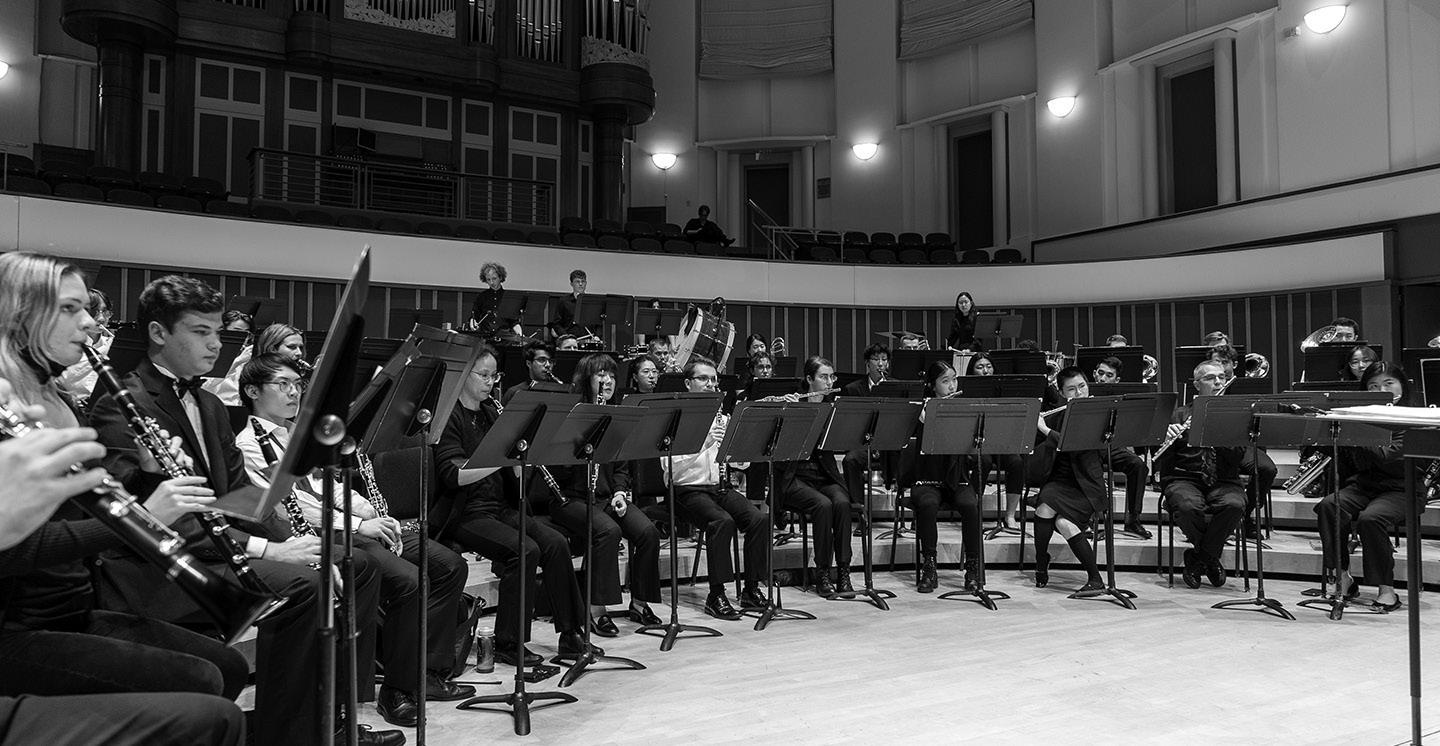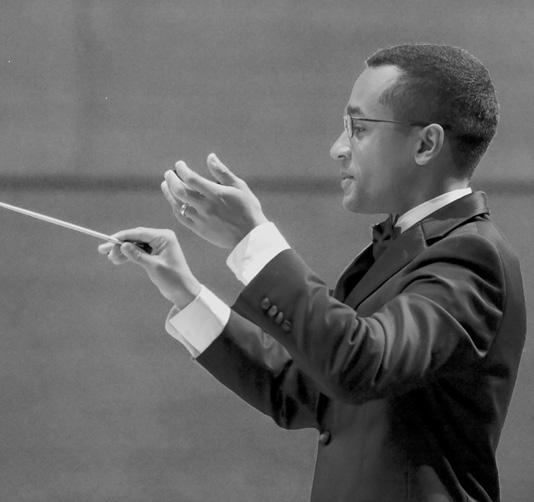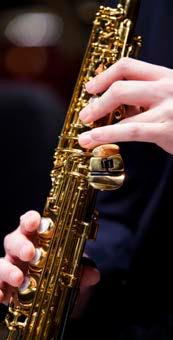








Welcome to the Schwartz Center for Performing Arts. Please turn off all electronic devices. Photography, recording, or digital capture of this concert is not permitted.
404.727.5050 | schwartz.emory.edu | boxoffice@emory.edu
Audience Information
The Schwartz Center welcomes a volunteer usher corps of about 40 members each year. Visit schwartz.emory.edu/volunteer or call 404.727.6640 for ushering opportunities.
The Schwartz Center is committed to providing performances and facilities accessible to all. Please direct accommodation requests to the Schwartz Center Box Office at 404.727.5050, or by email at boxoffice@emory.edu.
The Schwartz Center wishes to gratefully acknowledge the generous ongoing support of Donna and Marvin Schwartz.

Michael Kobito, conductor
Thursday, April 17, 2025, 8:00 p.m.
Emerson Concert Hall
Schwartz Center for Performing Arts
Bamboo Shoots and City Streets Benjamin R. Barker (b. 1995)
Forward/Still Omar Thomas (b. 1984)
Do Not Go Gentle Into That Good Night Elliot Del Borgo (1938–2013)
El Camino Real Alfred Reed (1921–2005)
Michael Kobito is a music educator, conductor, and trumpeter from Cartersville, Georgia. He serves as the conductor of the Emory Wind Ensemble and associate conductor of Tara Winds.

Prior to his appointment at Emory University, Kobito served as director of bands at Woodland High School in Cartersville. During his tenure as director, the band performed at multiple national events including the Cherry Blossom Festival Parade in Washington, D.C., the Georgia Music Educators Association In-Service Conference, the Southeastern United States Honor Band Festival, the Macy’s Thanksgiving Day Parade in New York City, University of Georgia’s Janfest Honor Band Festival, and most recently in the 2023 London New Year’s Day Parade. He also taught AP Music Theory, where his students earned a 100 percent pass rate on the AP exam.
As a conductor and trumpeter, Kobito is an active musician, performing regularly around metro-Atlanta in Tara Winds and the Georgia Brass Band. As a conductor of Tara Winds, the band was invited to perform in France at the 2023 Festival des Anches d’Azur in La CroixValmer, and locally at the 2024 GMEA In-Service Conference. Additionally, with these groups, Kobito has performed at multiple honor invitational events including the Midwest Clinic in Chicago and the North American Brass Band Competition in Fort Wayne, Indiana. He has served as a guest conductor for the Georgia Brass Band and has been the clinician for multiple honor bands around Georgia and the United States. He has been the recipient of the National Band Association Citation of Excellence for his work with the Woodland Band and Tara Winds on five occasions.
Kobito is a dedicated advocate for education, having served as an ambassador for educators in the state as the 2023 Georgia Teacher of the Year. He is an active keynote speaker, clinician, and panelist on topics around best education practices and pedagogy, teacher recruitment and retention, and the future of education.
This piece is an exploration of the blend between tradition and urbanization, inspired by bamboo shoots I saw growing in the middle of the pavement while on a walk with a friend. I wondered what it would sound like to tell the story of the resilience and adaptability of these bamboo shoots as they continued to grow and adapt in an everurbanizing environment.
I explored this concept by blending genres of music that represent both tradition and urbanization. Tradition is represented through the sounds of traditional Japanese music forms (such as gagaku or taiko), while urbanization is represented through the inclusion of elements of pop, rock, metal, and jazz. The piece begins in the midst of a forest of bamboo shoots. With each sudden percussive impact, a new shoot bursts through the ground. The woodwinds and xylophone assist us in moving forward while weaving through the narrow spaces between bamboo stalks. As the texture thins out and moves outside of the forest, we are suddenly thrust into an urban landscape.
The next section features stereotypical city sounds: car horns via muted trumpets, passing traffic in the trombones, and a general sense of busy hurriedness represented through the constantly moving and evolving textures. The string bass, drumset, low brass, and low reeds are frequently treated as a jazz rhythm section. It is also in this section that we are exposed to the introduction of the main theme of this piece (first seen in the horns at measure forty-four). This theme, for me, brought to mind the image of bamboo swaying in the wind, and returns multiple times in several environments throughout the piece, displaying the many places this bamboo is able to adapt and flourish. While the soundscape painted here sounds largely urban, it is important to note that the majority of material in this section is based on traditional Japanese music forms: the initial rhythmic figure in the horns and saxophones is derived from solo shamisen music, the woodwinds regularly interrupt phrases with shakuhachi-like motivic elements, many of the harmonies featured later in the section are directly taken from gagaku, and the initial “bamboo forest” triplet figures found in the xylophone and woodwinds, in the beginning, are hidden within the jazz saxophone solis. As all of these sounds and textures develop, they grow increasingly urgent and intense, building to an overwhelming extent.
Next, an escape into the countryside. The business and complexity of the city disappears, and we are able to reflect on the beauty of the bamboo in its more natural habitat. A modified form of our original bamboo forest theme, cognizant of a river, is developed in sequence to build into a new presentation of the main theme (rhythmically modified with transposed pitches, but otherwise the same). This restatement of the main theme is accompanied by the nostalgic sounds of a furin (wind chime), shakuhachi-like figures in the flutes, more fragments of the bamboo forest theme, and harmony that I largely associate with pop and rock music. We come to a full realization of the beauty of this scenery in measure 140, and then return to our sequential river texture from before which fades into a serene stillness.
Suddenly, in a very unexpected location, we are thrust back into the bamboo forest theme once again. This is the bamboo in the pavement: defiant and resolute. Taiko drums set an underlying determination that drives this section forward while an assortment of battle cries in the brass intermingle with the familiar sounds of festival music in the woodwinds. This section ebbs and flows, growing into a shameless metal groove before thrusting us, once more, into a majestic and powerful resurgence of the main theme. This theme reminds us of tradition’s firm roots that have persisted and adapted through an ever-urbanizing environment, continuing to grow in power and intensity up to the very last note.
—Program Note by composer
It was around my middle school years that I really began to fall in love with rich, complex, jazz-based harmony. This commission seemed like the perfect opportunity to give musicians at a similar point in their lives the opportunity to discover these same harmonies. What ended up manifesting was a meditation of the weight of our current sociopolitical and geopolitical turmoil. Those rich harmonies took the form of a stillness—a sort of requiem or dirge that mourned any sense of collectivity that we may have once enjoyed, no matter how tenuous or fragile. What has provided a bit of comfort is the fact that each generation has contended with events that have tested their humanity and capacity for growth. One thing that has been made abundantly clear throughout our collective story is that standing still is never an option. We must continue to move forward to create space, safety, and opportunity for those of us with the least. This idea of moving forward is represented in the second
section of the piece, which pushes its way upward towards our collective prosperity, in spite of the weight of the initial chorale. Following that is a brief, unresolved coda that reflects the uncertainty of our future and consequential nature of the decisions we make today. A deliberate sense of breath and heartbeat is created throughout the piece, reflected in the shapes of the phrases and in the spacious-yet-intentional percussion groove; the individual elements combining to create a living, breathing, unified body. May this piece serve as a meditative space, as catharsis, and as motivation to continue to search within ourselves to find what connects us all. Regardless of how hopeless circumstances become, we must move forward, still.
—Program Note by composer
The Dylan Thomas poem “Do Not Go Gentle into That Good Night” was the motivation for this musical composition. While not a programmatic depiction of the poem, the work attempts to recreate the essence of the poem in sound.
The opening motive, representative of the life force, permeates much of the work. An Ivesian use of sound layers—in the form of polytonal hymns—calls to mind the struggles and persistence of the human spirit and its refusal to “go gentle.”
—Program Note by composer
Do not go gentle into that good night, Old age should burn and rave at close of day; Rage, rage against the dying of the light.
Though wise men at their end know dark is right, Because their words had forked no lightning they Do not go gentle into that good night.
Good men, the last wave by, crying how bright Their frail deeds might have danced in a green bay, Rage, rage against the dying of the light.
Wild men who caught and sang the sun in flight, And learn, too late, they grieved it on its way, Do not go gentle into that good night.
Grave men, near death, who see with blinding sight Blind eyes could blaze like meteors and be gay, Rage, rage against the dying of the light.
And you, my father, there on the sad height, Curse, bless, me now with your fierce tears, I pray. Do not go gentle into that good night. Rage, rage against the dying of the light.
Do Not Go Gentle into That Good Night was commissioned in 1978 to commemorate Jill Marie Waterland and Mandy Doel, Del Borgo’s two students who were tragically killed in a car accident. Based on Dylan Thomas’s poem of the same name, Del Borgo wanted to embody the “essence” of the poem.
—Program Note from State University of New York, Fredonia, All-College Band concert program, November 8, 2017
El Camino Real
El Camino Real (literally “The Royal Road” or “The King’s Highway”) was commissioned by, and is dedicated to, the 581st Air Force Band (AFRES) and its commander, Lt. Col. Ray E. Toler. Composed during the latter half of 1984 and completed in early 1985, it bears the subtitle “A Latin Fantasy.”
The music is based on a series of chord progressions common to countless generations of Spanish flamenco (and other) guitarists, whose fiery style and brilliant playing have captivated millions of music lovers throughout the world. These progressions and the resulting key relationships have become practically synonymous with what we feel to be the true Spanish idiom. Together with the folk melodies they have underscored, in part derived by a procedure known to musicians as the “melodizing of harmony,” they have created a vast body of what most people would consider authentic Spanish music.
The first section of the music is based upon the dance form known as the jota, while the second, contrasting section is derived from the fandango, but here altered considerably in both time and tempo from its usual form. Overall, the music follows a traditional three-part pattern: fast-slow-fast.
The first public performance of El Camino Real took place on April 15, 1985, in Sarasota, Florida, with the 581st Air Force Band under the direction of Lt. Col. Ray E. Toler.
—Program Note by composer
The Emory Wind Ensemble (EWE) is a nationally recognized organization dedicated to performing wind literature of the highest caliber while nurturing individual artistic excellence within an ensemble setting. Membership is determined by audition each fall. Concert programming comprises a wide variety of styles, forms, and genres from several centuries of compositional practice, designed to provide comprehensive exposure to the masterpieces for winds and percussion from the Renaissance period through the modern era. A flexible instrumentation is employed with predominantly one player per part, giving students the opportunity to experience true wind ensemble performance practice.
The EWE performs two concerts each semester, regularly participates in world premieres of new music, tours the United States and abroad, and is a national leader in the commissioning of new music, including works by Warren Benson, Steven Bryant, Stephen Paulus, Bruce Broughton, Jennifer Higdon, Libby Larsen, John Mackey, David Maslanka, Jonathan Newman, and many others. In 2017, the ensemble was showcased by the College Band Director’s National Association among its peer institutions with a citation for musical excellence at the “Small Band Showcase,” presented at the Association’s National Conference in Kansas City.
The EWE’s recent collaborations include performances with the Emory University Chorus; the Emory Dance Company; Emory’s Mary Emerson Professor of Piano William Ransom; Chris Martin, principal trumpet of the New York Philharmonic; Stuart Stephenson, principal trumpet of the Atlanta Symphony Orchestra; Joe Alessi, principal trombone of the New York Philharmonic; Adam Frey, international euphonium solo artist; and Grammy Award–winning solo clarinetist Richard Stoltzman.
The EWE has performed concert tours of Munich, Salzburg, Innsbruck, Lucerne, Graz, Prague, Vienna, and Greece. Additionally, it has performed at the Georgia Music Educators Association (GMEA) State Convention in Savannah, Georgia; at the Southern Division College Band Directors National Association Conference (CBDNA); and for various events on Emory’s campus, including the inauguration of James Wagner as president of Emory University. Most recently, a brass ensemble made up of EWE members performed live during a national broadcast by the National Basketball Association. The EWE is recorded on the NAXOS and Centaur music labels.
Sections listed alphabetically
Flute / Piccolo
Aricka Boosa
Hannah Huang
Aldo Rios
Sophia Song
Rosie Wu
Oboe / English Horn
Sissi Chen
Amber Ford
Zachary Kant
Zlang Zhang
Clarinet
Kayla Bak
Jamie Eck
Ian Moon
Joe van Duyn
Nick Wandrick
Bass Clarinet
Nicole Bring
Sam Chernoff
Saxophone
Abby Balson
Martin Lin
Andy Nguyen
Jonathan Uhlengerg
Bassoon
Nicole McGill
Horn
Aditya Dutta
Josh Lee
Justin Wang
Trumpet
Ian LaBreck
Natalie Park
William Sun
Austin Watkinson
Trombone / Bass Trombone
Tim Brewer
Chris Cheong
Ethan Hsuing
Jakob Ostheimer
Euphonium
Tyler Edwards
Tuba
Michael Amsel
Anna Gayler
Piano
Jonathan Lou
Percussion
Nellie Gregg
Meredith Liu
Aiden Neuser
Mingyu Zhang
Sunny Zheng


Music at Emory brings together students, faculty, and world-class artists to create an exciting and innovative season of performances, lectures, workshops, and master classes. With more than 150 events each year across multiple Emory venues, audiences experience a wide variety of musical offerings.
We hope you enjoy sampling an assortment of work from our student ensembles, community youth ensembles, artists in residence, professional faculty, up-and-coming prodigies, and virtuosos from around the world.
music.emory.edu



